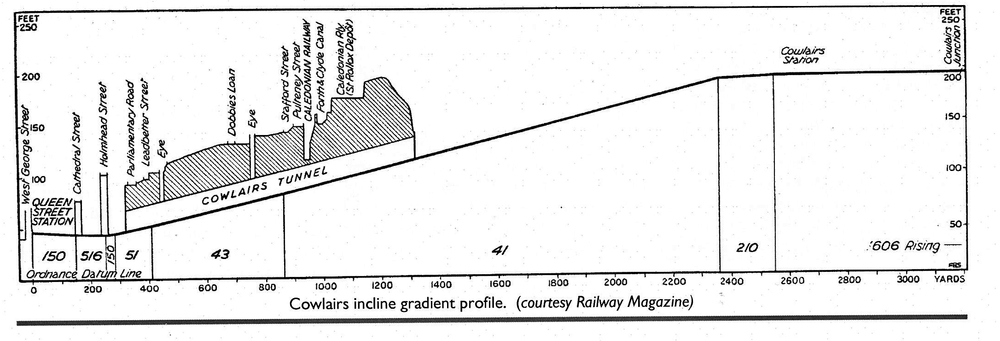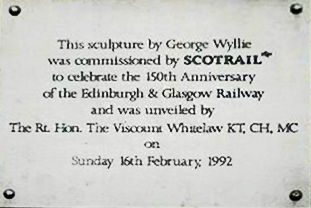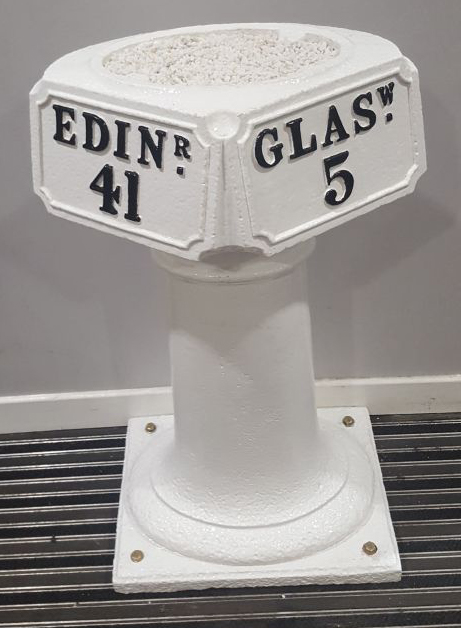
Scotland's first inter-city line runs the forty-seven and three-quarter miles from Edinburgh Waverley via Falkirk High to Glasgow Queen Street. Absorbed by the North British Railway in 1865.
Glasgow Queen Street Station
N Hanover St
Constructor : the Edinburgh & Glasgow Railway in 1842, engineer John Miller
Scotland's first inter-city line runs the forty-seven and three-quarter miles from Edinburgh Waverley via Falkirk High to Glasgow Queen Street. Absorbed by the North British Railway in 1865.
Until 1846 when the line through Princes Street Gardens with tunnels at both ends was completed, the Edinburgh terminus was Haymarket. The only town encountered en route was the historic royal burgh of Linlithgow, birthplace of Mary Queen of Scots where care had to be taken in threading the line through existing properties. Gradients were minimised by providing great viaducts across the Rivers Almond and Avon and by having tunnels at Winchburgh and Falkirk. However the E&G's plan for a virtually gradient-free route was thwarted by the canal company, whose insistence that the railway must pass beneath it resulted in the one-and-a-quarter-mile 1 in 41 Cowlairs Incline up which until 1908 trains had to be worked by cable powered from a stationary steam engine.

The Liverpool and Manchester Railway opened in 1830 was more successful than its promoters expected, and showed that an intercity railway could be commercially successful. The pressure to connect the two great cities of central Scotland continued, and in the second half of the 1830s money became freely available, and investors, chiefly in England (many of them shareholders in the Liverpool and Manchester line), promoted a viable railway. Whereas lines like the Stockton and Darlington and Liverpool and Manchester were conceived with freight as the main consideration, the Edinburgh & Glasgow put passengers first, and soon captured the public imagination. The first station in the world to be photographed was Linlithgow, by pioneers Hill and Adamson in 1845.

A plaque unveiled in 2005 on Haymarket Station marked the bicentenary of John Miller's birth.

The E&G had distinctive cast-iron mileposts derived from the turnpike practice, showing the mileages to Haymarket and Queen Street : examples have been preserved at both stations and in the Museum of Scotland , the railway museum at Bo'ness and the Auld Kirk Museum at Kirkintilloch.
The original trainshed from Haymarket now forms part of the Bo-ness and Kinneil Railway station at Bo'ness. Falkirk High has a sculpture, Antonine : the Legendary Engine by George Wyllie.
The E&G's history has been punctuated by accidents, notably December 1937's Castlecary rear-end collision in snow which was Britain's worst between the wars, and Polmont in 1984 when a driving trailer hit a cow which had gone onto the line through a broken fence.
Until the 1960s the route's flagship train was the “Queen of Scots” Pullman linking Glasgow with Leeds via Harrogate, but all East Coast Anglo-Scottish trains now run to Glasgow Central via Motherwell. Swindon inter-city diesel multiple-units took over the E&G in 1957, becoming half-hourly in 1967 and being replaced by push-pull sets with Class 27 locomotives in 1971. A decade later Class 47s took over, until the arrival in 1990 of Class 158s and in turn were replaced by Class 170s from 1999, when the frequency was increased to every 15 minutes. Croy joined the route, soon acquiring Scotland's largest station car-park. In 2017 the Edinburgh Glasgow Improvement Programme brought about electrification of the High Level platforms, and in 2019 new Hitachi Class 385 multiple-units came into operation.
During electrification, the height of walls in Linlithgow had to be increased in accordance with new standards on putting overhead wires out of reach, and traditional techniques of wall-building were used. Rebuilding of Queen street and platform-lengthening elsewhere have increased the maximum train-length to eight carriages.
Photo credits: Ann Glen; Richard Webb / Almond Valley viaduct; John Yellowlees
Queen Street Station is actually on West George Street, and faces down Queen Street from the top of George Square, with a side entrance onto North Hanover Street.